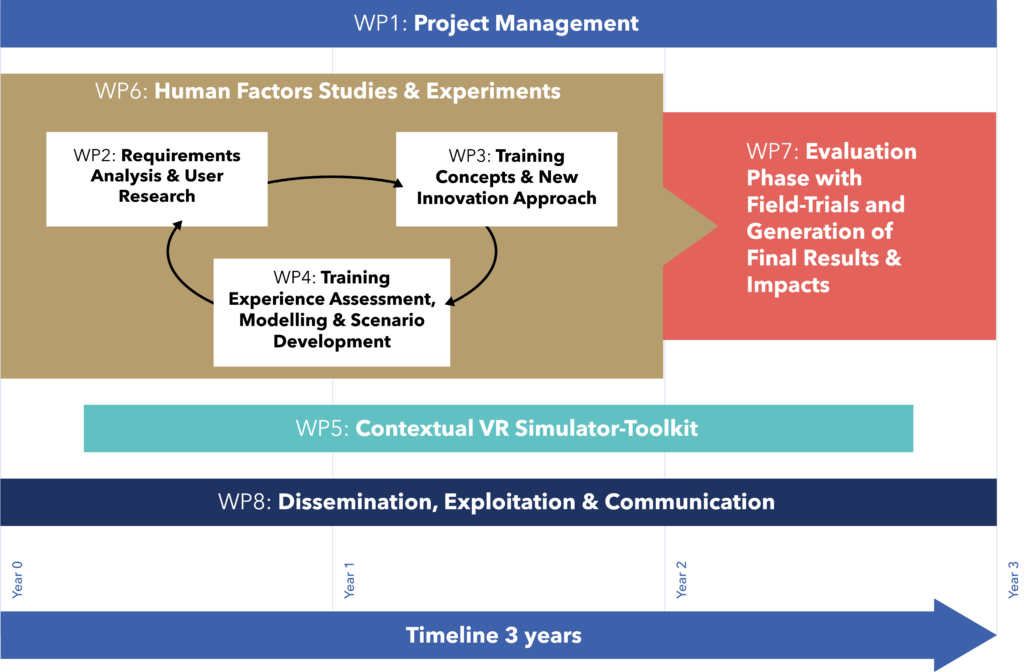Elements and Structure of Work Packages
The work plan of SHOTPROS is divided into 9 distinct work packages, altogether lasting 36 months. Since the work is highly collaborative, several partners will be involved in each of the work packages.

Learn more about the work packages of SHOTPROS:
This work package aims to ensure the successful execution and completion of the project and to manage the project in a target-focused manner. The project coordinator ensures that all deliverables are submitted in time, milestones are met, and risks are minimized.
The first operational work package, WP2, focuses on analysing and uncover the requirements from different stakeholders involved in police trainings (e.g. trainer, trainee, academy leads, etc.) and several perspectives (e.g. organisational, cultural, societal, etc.). It will also investigate the societal impact of police DMA on citizens’ perspectives on police legitimacy and trust and will help at incorporating the needs of EU citizens in the project as well.
In WP3 a conceptual model of behaviour, including different contextual and human factors that influence perception, decision-making and acting in a potentially threatening situation will be created. WP3 will prepare a research agenda to validate (in WP6) the DMA-SR model and create the needed training concepts, methods and tools.
Work in WP2-3 will be performed in parallel and will serve as input to WP4. The main objectives of WP4 are creation and validation of a psychological and physiological cue repository, prototyping the VR scenarios and the performance dashboard for trainers (WP5, WP7), develop a psychophysiological measurement suite and define the technical requirements for the VR Simulator Toolkit (for WP5). Furthermore, a risk assessment toolkit to identify high-risk situations will be developed.
The objective of WP5 is to provide and develop the necessary VR infrastructure, VR technical knowledge and software components for conducting the human factors studies (WP6) and the end user field-trials (WP7).
The main objective of WP6 is the preparation (planning, measurement tools etc.) and execution of the human factor experiments and studies that have to be carried out in accordance with the research questions addressed in WP2-4. To achieve maximal ecological validity, these studies and experiments will be executed at the premises of the LEAs and recruiting test subjects among them.
The results from the previous WPs will now be evaluated and improved from direct feedback of the LEAs (within the consortium and external LEAs). The results from WP 2-6 will be evaluated in field-trials at the different LEAs (on-site) and at the final SHOTPROS conference
The coordinator and WP8 leader USE will organise together with all partners the communication with external stakeholders as part of dissemination activities. Such communication will be facilitated through the website (e.g. www.shotpros.eu) and the various dissemination activities as described in the impact section.
Ethical guidelines and procedures will be established and prepared for all consortium members to adhere to during the entire research and development and testing of the SHOTPROS System. These ethical guidelines will focus on related consent and confidentiality procedures of the end users of the system as well as the protection of any collected data.
The task leader will monitor all activities within the project to make sure that they follow the ethical guidelines and procedures.
Deliverables of SHOTPROS
All public deliverables of the project are presented in the table below and can be accessed once they are finalized and accepted by the EC. Klick on the red deliverables to view and download them. If you have any questions about the content do not hesitate to contact SHOTPROS.
